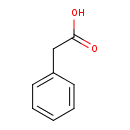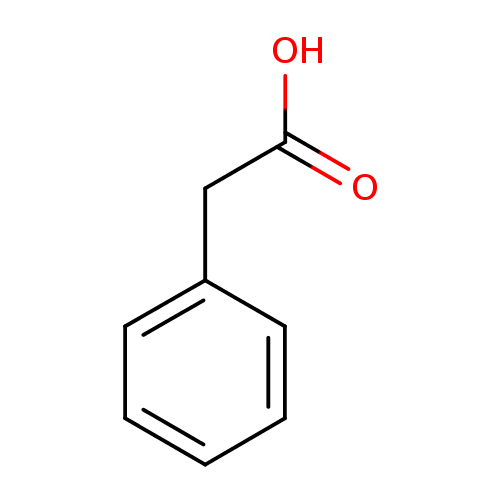|
Record Information |
|---|
| Version |
1.0 |
|---|
| Update Date |
1/22/2018 11:54:54 AM |
|---|
|
Metabolite ID | PAMDB120357 |
|---|
|
Identification |
|---|
| Name: |
phenylacetate |
|---|
| Description: | A monocarboxylic acid anion that is the conjugate base of phenylacetic acid. |
|---|
|
Structure |
|
|---|
| Synonyms: | - 2-phenylethanoate
- phenylacetate
- phenylacetate anion
- phenylacetate(1−)
- phenylacetic acid anion
|
|---|
|
Chemical Formula: |
C8H7O2 |
|---|
| Average Molecular Weight: |
135.142 |
|---|
| Monoisotopic Molecular
Weight: |
136.05243 |
|---|
| InChI Key: |
WLJVXDMOQOGPHL-UHFFFAOYSA-M |
|---|
| InChI: | InChI=1S/C8H8O2/c9-8(10)6-7-4-2-1-3-5-7/h1-5H,6H2,(H,9,10)/p-1 |
|---|
| CAS
number: |
103-82-2 |
|---|
| IUPAC Name: | phenylacetate |
|---|
|
Traditional IUPAC Name: |
?-phenylacetic acid |
|---|
| SMILES: | C1(=CC=C(C=C1)CC([O-])=O) |
|---|
|
Chemical Taxonomy |
|---|
|
Taxonomy Description | This compound belongs to the class of organic compounds known as benzene and substituted derivatives. These are aromatic compounds containing one monocyclic ring system consisting of benzene. |
|---|
|
Kingdom |
Organic compounds |
|---|
| Super Class | Benzenoids |
|---|
|
Class |
Benzene and substituted derivatives |
|---|
| Sub Class | Not Available |
|---|
|
Direct Parent |
Benzene and substituted derivatives |
|---|
| Alternative Parents |
|
|---|
| Substituents |
- Monocyclic benzene moiety
- Monocarboxylic acid or derivatives
- Carboxylic acid
- Carboxylic acid derivative
- Organic oxygen compound
- Organic oxide
- Hydrocarbon derivative
- Organooxygen compound
- Carbonyl group
- Aromatic homomonocyclic compound
|
|---|
| Molecular Framework |
Aromatic homomonocyclic compounds |
|---|
| External Descriptors |
|
|---|
|
Physical Properties |
|---|
| State: |
Solid |
|---|
| Charge: | -1 |
|---|
|
Melting point: |
76.7 °C |
|---|
| Experimental Properties: |
| Property | Value | Reference |
|---|
| Melting Point | 76.7 °C | Not Available | | Boiling Point | Not Available | Not Available | | Water Solubility | 16.6 mg/mL | Not Available | | LogP | 1.41 | HANSCH,C ET AL. (1995) |
|
|---|
| Predicted Properties |
|
|---|
|
Biological Properties |
|---|
| Cellular Locations: |
Not Available |
|---|
| Reactions: | |
|---|
|
Pathways: |
|
|---|
|
Spectra |
|---|
| Spectra: |
|
|---|
|
References |
|---|
| References: |
- Jankowski J, van der Giet M, Jankowski V, Schmidt S, Hemeier M, Mahn B, Giebing G, Tolle M, Luftmann H, Schluter H, Zidek W, Tepel M: Increased plasma phenylacetic acid in patients with end-stage renal failure inhibits iNOS expression. J Clin Invest. 2003 Jul;112(2):256-64. [12865413 ]
- Pontoni G, Rotondo F, Spagnuolo G, Aurino MT, Carteni-Farina M, Zappia V, Lama G: Diagnosis and follow-up of cystinuria: use of proton magnetic resonance spectroscopy. Amino Acids. 2000;19(2):469-76. [11128553 ]
- Rubin A, Knadler MP, Ho PP, Bechtol LD, Wolen RL: Stereoselective inversion of (R)-fenoprofen to (S)-fenoprofen in humans. J Pharm Sci. 1985 Jan;74(1):82-4. [3920382 ]
- Davis BA, Kennedy SH, D'Souza J, Durden DA, Goldbloom DS, Boulton AA: Correlations of plasma and urinary phenylacetic acid and phenylethylamine concentrations with eating behavior and mood rating scores in brofaromine-treated women with bulimia nervosa. J Psychiatry Neurosci. 1994 Jul;19(4):282-8. [7918350 ]
- Silvennoinen R, Malminiemi K, Malminiemi O, Seppala E, Vilpo J: Pharmacokinetics of chlorambucil in patients with chronic lymphocytic leukaemia: comparison of different days, cycles and doses. Pharmacol Toxicol. 2000 Nov;87(5):223-8. [11129502 ]
- Ostergaard J, Larsen C: Bioreversible derivatives of phenol. 2. Reactivity of carbonate esters with fatty acid-like structures towards hydrolysis in aqueous solutions. Molecules. 2007 Oct 30;12(10):2396-412. [17978765 ]
- Lorentz K, Flatter B, Augustin E: Arylesterase in serum: elaboration and clinical application of a fixed-incubation method. Clin Chem. 1979 Oct;25(10):1714-20. [476920 ]
- Sabelli HC, Fawcett J, Gusovsky F, Javaid J, Edwards J, Jeffriess H: Urinary phenyl acetate: a diagnostic test for depression? Science. 1983 Jun 10;220(4602):1187-8. [6857245 ]
|
|---|
| Synthesis Reference: |
Zhou, Shu-jing; Li, Jin-lian; Luan, Fang. New synthetic method for benzeneacetic acid. Huaxue Yu Shengwu Gongcheng (2005), 22(2), 43-44. |
|---|
| Material Safety Data Sheet (MSDS) |
Download (PDF) |
|---|
|
Links |
|---|
| External Links: |
|
|---|


